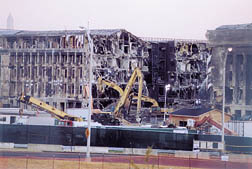
"While the horrific loss of life and the attack on our country makes this event one of the blackest in American history, few people know how extensive the damage to the Pentagon was," says Lauren Reid, vice president and general manager of Munters Moisture Control Services, Glendale Heights, Ill., the largest water damage recovery company in North America.
In addition to the impact of the crash itself, water damage from shattered sprinklers and water lines also added to the devastation. Millions of gallons of water flowed throughout the building after the attack. In some areas, water was 18 inches deep.
While Munters isn't the type of contractor PM covers, they were called in by the type we do. For the past several years, mechanical contractor John J. Kirlin Inc. has been involved in various renovation projects at the Pentagon. Saving as much of that renovation work as possible was the reason Kirlin needed the help. Making a conservative estimate, Reid believes Munters saved the Pentagon more than $40 million in reconstruction expenses.
After getting the job, "Munters' equipment started showing up within hours," says David Rosner, project manager for John J. Kirlin. "They methodically set up and acted swiftly to new requests and changes."
It's off our beaten path, but we think Munters' work offers one other look at the aftermath of the terrorist attacks.
Pentagon building managers describe their building as composed of five "wedges." Each wedge has a corner of the building at its center. The attack occurred between Wedge 1 and Wedge 2 with fire and water damage occurring on both sides of the crash site.
Certainly some parts of Wedges 1 and 2 were destroyed and could only be slated for demolition and reconstruction. Areas that remained structurally sound in Wedge 1 were the focus of much of Munters' work. (Wedge 2 was given a lower priority since the area was already scheduled to be gutted for future renovation and asbestos removal.)
Adding to the devastation was the time that went by since the FBI and military gave first priority to national security than to clean up. After security issues concluded, Munters divided Wedge 1 into different zones based on the type and extent of damage: Zone A, nearest the crash site, the water damage was deemed "devastating" and mold growth reached well up the walls and, in some cases, was 2 inches thick on carpet. In Zone B water damage was "very heavy" and mold growth was "substantial." Finally, in Zone C, water damage was the least of the three zones and mold was "minor."
The Munters crew originally focused on Zones B and C.
"Zone C needed to be addressed without further delay," says Joe Kelley, Munters' Washington D.C. district manager. "We knew after a simple walk-through that we could save millions in new construction." As bad as it was, Kelley believed that area could be dry enough for use in less than a week.
With Zone B, Kelley's plan was to save at least 60 percent of the drywall, and all of the new structural and mechanical materials.
Dehumidifiers drew in outside air, dried it to an extremely dry condition and then air movers and a network of flexible ducts pumped the air into damaged areas. At the same time, air scrubbers filtered the air for dust and mold spores.
Meanwhile, Zone A was so bad that workers had to wear respirators to enter. A decision had been made to bulldoze everything, but officials decided to let Munters try to dry the area. Drywall and carpet was beyond hope, but Munters saved the Pentagon millions in new structural material, plus electrical and mechanical equipment.
Munters eventually had more than 600 pieces of drying equipment distributing 1.5 million cubic feet of dry air each minute through more than a mile of ductwork to dry out the Pentagon.

Sidebar: Donations To Imran Khan Scholarship Fund Reach More Than $120,000
More than $120,000 has been donated to the Imran Khan Scholarship Fund, according to the PHCC-NA. The total includes a recent $15,000 donation made by the UA at the Union-Affiliated Contractor Meeting last April in Hollywood, Fla."We are extremely pleased that industry representatives and individuals alike have contributed such a significant amount to this worthwhile project," said PHCC President Bill Trombly. "As a result, a very talented and intelligent young man will have the opportunity to pursue an education at the college of his choice."
Imran, 13, is the son of the late Norma Khan, a PHCC staff member who was a victim of the Sept. 11 plane crash into the Pentagon. The fund was established in memory of her service to PHCC and the industry.
Contributions may be sent to the PHCC Educational Foundation Scholarship Fund, 180 S. Washington St., Falls Church, VA 22046. Please indicate either on a check or an attached sheet of paper that you would like the donation to be made toward the Imran Khan Scholarship Fund.